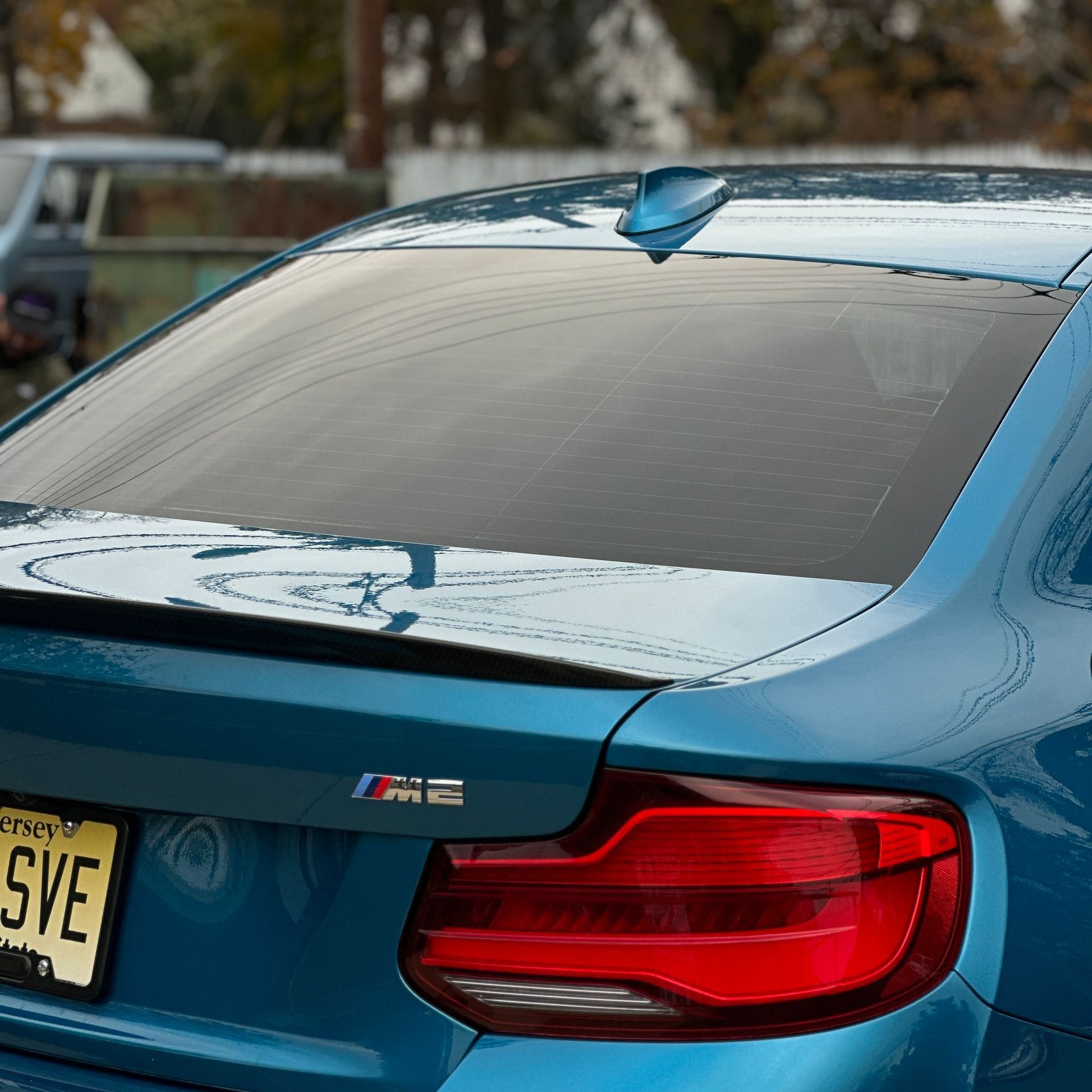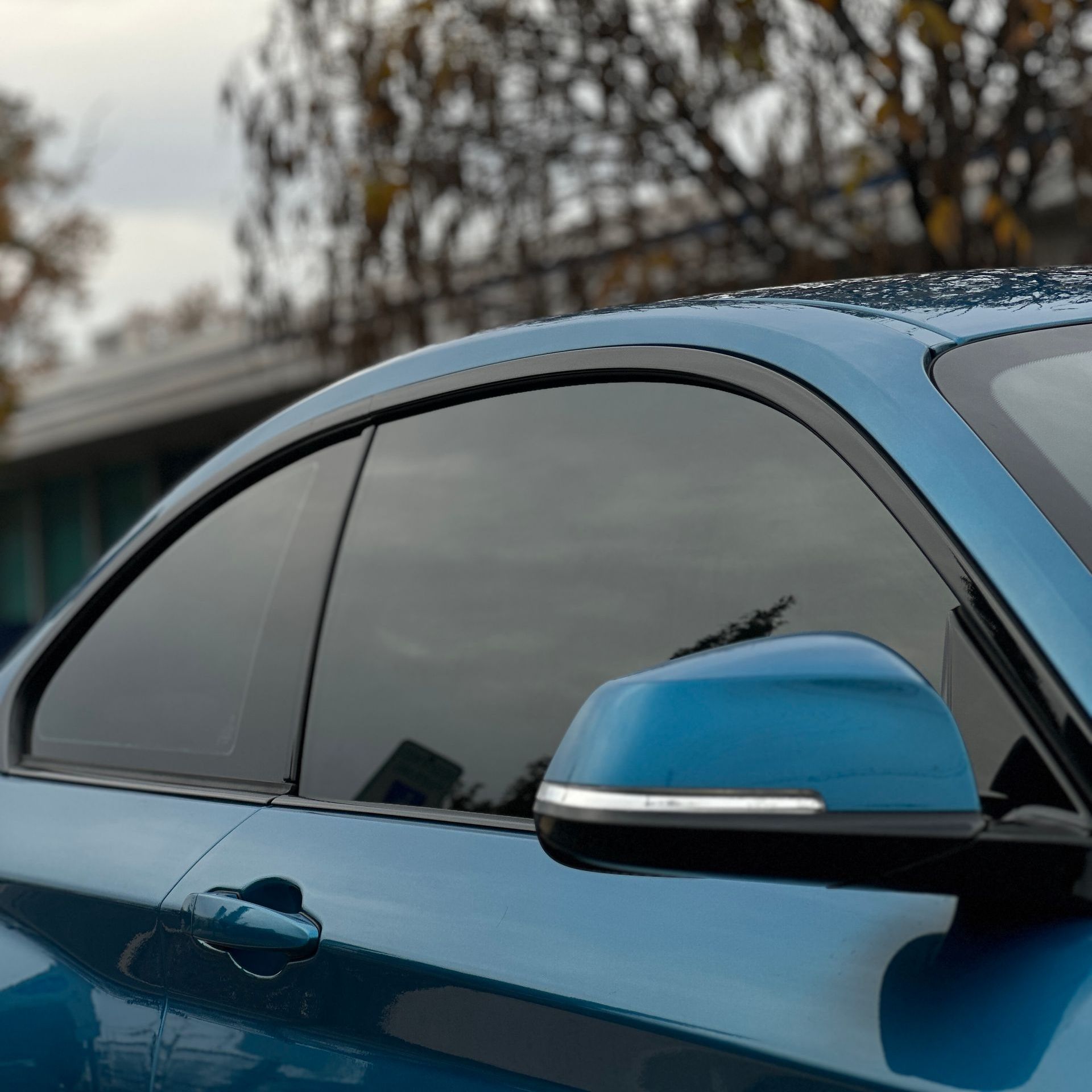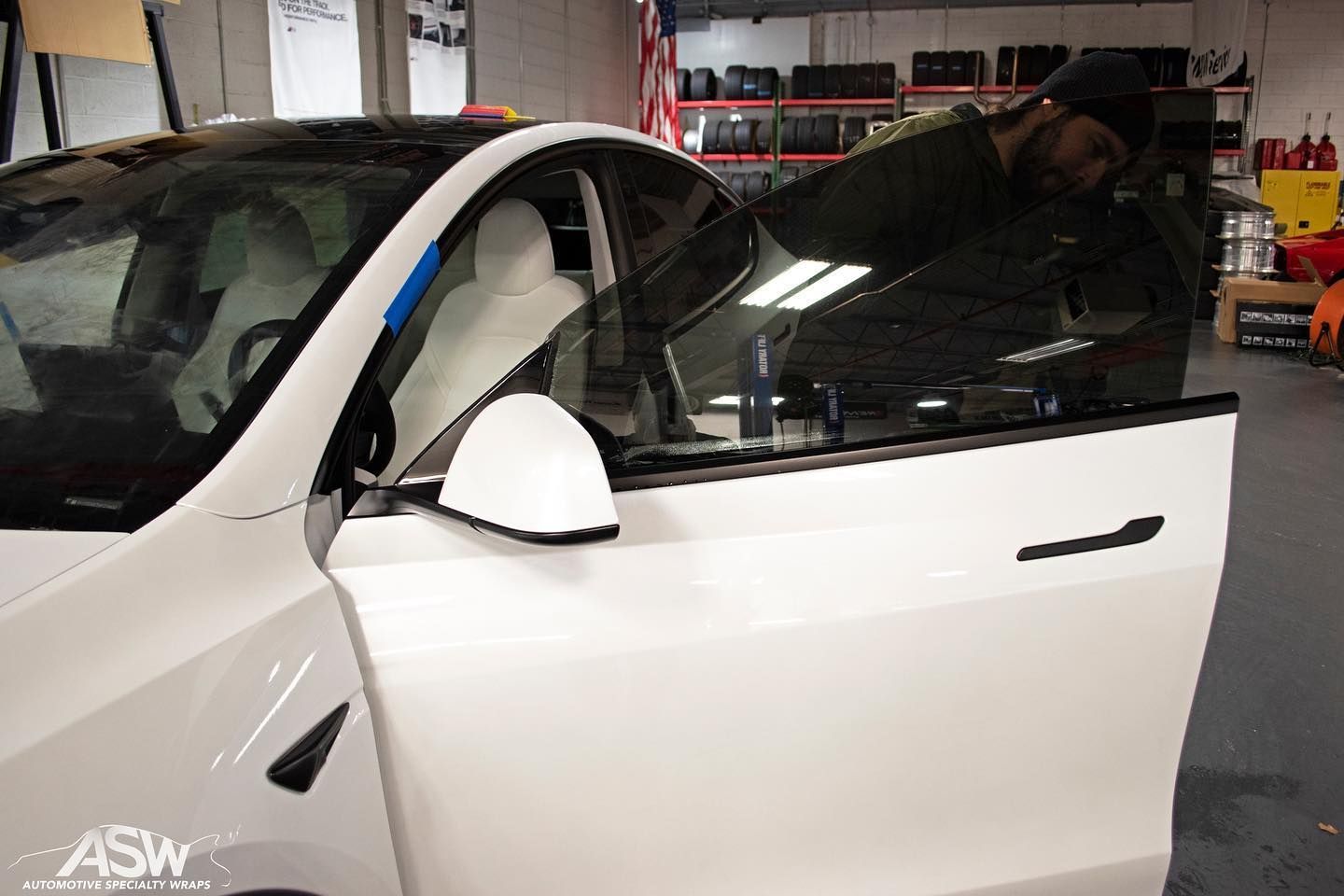Auto Window Tinting: How It Works and Its Benefits for Your Car
GET A FREE ESTIMATEWhen you're on the road, comfort and security are two things you can't overlook—especially when it comes to your car. You might think that auto window tinting is just about looking cool, but it’s actually a smart investment for your vehicle. In this article, we'll break down how auto window tinting works, the different types available, and why it's worth considering for your driving experience.
Auto window tinting is the application of a specialized film to vehicle windows that provides several benefits, including UV protection, heat reduction, and enhanced privacy. The process involves cleaning the windows, cutting the film accurately to fit each window, applying it with a soapy water solution for proper adhesion, and allowing it to cure for optimal results.
What Is Auto Window Tinting?
Auto window tinting is more than just a cosmetic upgrade; it's a carefully thought-out process that offers tangible benefits for both vehicle and driver. At its core, this process involves applying a thin film to the car's windows, effectively darkening them. This film is commonly manufactured from polyethylene terephthalate (PET), a type of polymer resin from the polyester family, known for its clarity, durability, and capacity to incorporate various treatments on its surface. The utility of window tinting extends far beyond mere aesthetics. For starters, it provides an essential layer of privacy. Imagine parking your car in a crowded area; with tinted windows, you can enjoy peace of mind knowing prying eyes can't easily see inside. This feature becomes especially crucial for those who often leave valuables in their vehicles or simply appreciate having a personal space protected from external scrutiny.
Beyond privacy, another significant advantage comes into play: reduced glare. Anyone who's driven during that awkward time between sunset and twilight knows how blinding sunlight can obstruct visibility, making driving discomforting and even dangerous. Tinted windows help minimize this glare, enhancing safety on the road—an aspect highly valued by drivers who frequently traverse sun-soaked peaks or open highways. Perhaps one of the most compelling reasons people choose window tinting lies in its protective qualities against UV radiation. Studies have shown that excessive exposure to ultraviolet rays can lead to skin damage and increase the risk of skin cancer—a concern echoed by many urban dwellers who spend long hours commuting.
Window tinting doesn't just safeguard passengers; it also protects your vehicle's interior from harmful solar rays that can cause upholstery fading and dashboard cracking. By reducing heat buildup inside the car, these films contribute to an overall cooler environment in the summer months while preventing harmful wear over time. Yet it isn’t just about protection or comfort—the aesthetic appeal is undeniably persuasive. Tinted windows give cars a sleek, polished look that many drivers find irresistible. Whether you’re drawn in by that sporty appearance or simply enjoy an upgraded feel, adding tint can dramatically enhance your vehicle's profile.
The blend of these attributes—privacy, glare reduction, UV protection, and aesthetic enhancement—has led to increasing popularity among car owners. Understanding these facets not only helps potential customers make informed decisions but also highlights why investing in quality auto window tinting is worthwhile for anyone looking to enhance their driving experience.
Types of Window Tinting Film
The market hosts an assortment of window tinting films, designed to cater to a diverse set of needs and preferences. Selecting the right one can feel daunting at first. However, getting familiar with each type’s characteristics can simplify the process immensely. Here are some popular types you may encounter:
- Dyed Film: It consists of multiple layers of dye that work together to absorb solar heat. While it provides privacy and reduces glare, it's not known for high UV protection. Over time, it can fade, especially with consistent exposure to direct sunlight, affecting your vehicle's aesthetics.
- Metalized Film: This design effectively blocks both heat and UV rays. However, while it excels in temperature regulation and glare reduction, users report potential interference issues with GPS signals or radio reception. If your car depends on navigation systems, consider this before choosing metalized tinting.
- Carbon Film: This option strikes an impressive balance by offering substantial UV protection without causing signal interference like its metalized counterpart might. Carbon films maintain their aesthetic appeal over time without fading easily. Users appreciate its matte finish and durability, contributing to its growing popularity among car owners seeking effective performance without compromising visual style.
- Ceramic Film: This top-tier option excels in providing exceptional clarity combined with unbeatable UV protection and heat rejection capabilities. Even lighter shades can effectively keep harmful rays out while maintaining clear visibility inside the vehicle. Although ceramic films come with a heftier price tag, many find it an investment worth making for long-term comfort and safety benefits.
Understanding these types helps you navigate through your selection process more confidently, ensuring that you choose a window film that aligns perfectly with your specific needs and aesthetic preferences. With this knowledge in hand, we will now explore the critical aspects involved in applying window tint effectively.
Application Process of Tinting Film
Applying tinting film is a meticulous process that requires both skill and precision. While some enthusiasts may attempt a DIY approach, trusting professionals often yields the best results. Each step in this process is crucial, impacting both the aesthetic quality and the long-lasting performance of the tint.
- Preparation: A clean surface is essential for how well the film adheres to your windows. This isn't just about appearance; it's about creating a solid foundation for your new tint. A simple solution of soapy water can make a significant difference. Thoroughly washing your windows with this mixture not only removes dirt and grime but also eliminates any dust particles that could interfere with a smooth application. It’s important to dry them afterward to ensure no debris remains.
- Cutting the Film: Once your windows are sparkling clean, it’s time for one of the most critical phases—cutting the film. Precision is vital in this step; accurately measuring each window ensures that, once applied, there won't be any unsightly gaps or misalignment issues detracting from your vehicle's look. Professionals often use a peel board during cutting, allowing them to easily handle the film while ensuring precise cuts that fit seamlessly over the windows.
- Application: To facilitate a smooth installation and minimize air bubbles, a second soapy water solution is generously sprayed on both the window and the film. This technique creates a lubricated layer that allows for easy adjustments before it sets. The installer then uses a squeegee to gently eliminate moisture and trapped air bubbles beneath the film's surface. It's crucial to work methodically, ensuring that each inch adheres correctly without imperfections.
- Final Checks: Examining every corner and edge allows installers to catch any small flaws before they become permanent problems. Once satisfied with their work, they recommend waiting at least three days before rolling down the windows. This waiting period allows for complete curing, ensuring that all adhesion processes finalize successfully and preserving the longevity of your new tint.
Each step in this application process highlights its significance; flawless window tinting enhances comfort, safety, and driving experience.
Benefits of Auto Window Tinting
Window tinting is not just a fashionable choice; it brings practical advantages that significantly enhance the quality of your driving experience. The protective film applied to your windows serves as a barrier, shielding you and your vehicle from various environmental stressors while adding a sleek aesthetic.
- UV Protection: One of the standout benefits of window tinting is its ability to block harmful ultraviolet (UV) rays. This remarkable filtration helps protect your skin from potential damage associated with prolonged exposure, such as skin cancer. By opting for window tinting, you're essentially adding an invisible layer of defense for both you and your passengers.
- Heat Reduction: Beyond UV protection, quality window tints excel at heat reduction. Imagine stepping into your vehicle on a hot summer day and feeling a stark difference in temperature. Many car owners report that their interiors remain significantly cooler after applying window tints. Lower internal temperatures also lessen the strain on air conditioning systems, leading to energy savings and increased fuel efficiency.
- Glare Reduction: Safety is paramount when driving, and window tinting plays a pivotal role in enhancing visibility. Tinted windows effectively reduce glare caused by bright sunlight or oncoming headlights, particularly during early mornings or late afternoons. By creating a more controlled light environment inside your vehicle, you can focus better on the road ahead without squinting through distracting glare. This improvement alone makes tinted windows an invaluable addition for every driver concerned about safety.
- Interior Protection: Another significant advantage is the preservation of your vehicle's interior. Prolonged sun exposure can lead to fading upholstery and cracking dashboards over time, resulting in depreciation of your car's value. Window tint acts as a shield against these damaging rays, helping maintain the vehicle's aesthetic appeal and functionality over the years. This added protection contributes towards higher resale values if you decide to sell or trade in your car down the line.
With an understanding of these benefits, we can shift our focus to how these enhancements translate into improved privacy and security for drivers and their valuables.
Privacy and Security Advantages
One of the most underrated aspects of window tinting is its capability to create a barrier between your personal space and the outside world. When you have tinted windows, it becomes increasingly difficult for prying eyes to glimpse inside your vehicle. This added layer of obscurity offers significant peace of mind, especially when parked in public spaces or high-traffic areas where people may be tempted to peer in.
Privacy
It's akin to drawing the curtains in your home: while you can still enjoy the scenery outside, no one can invade your privacy by intruding into your personal space. Tints give you that same comfort in your car, allowing you to enjoy the world around you without exposing yourself to unwelcome attention. This factor is particularly crucial if you're transporting children or other sensitive belongings. Having tinted windows means less chance of unwanted distractions or interactions while you're on the go, making for a more serene travel experience. But the advantages extend well beyond just deterring curious onlookers.
Security
Tinted windows also contribute an extra layer of security by reinforcing the integrity of your windows themselves. The film applied during tinting holds shattered glass together in case of an impact, creating less risk for injury from flying shards. This feature not only protects the passengers but also maintains the overall structure of the vehicle during accidents. Furthermore, vehicles equipped with tinted windows are statistically less likely to suffer theft and break-ins.
Together, these privacy and security benefits transform window tinting from a simple cosmetic upgrade into an essential protective measure for both you and your vehicle's contents.
In conclusion, auto window tinting offers far more than a sleek appearance—it’s a practical upgrade that enhances comfort, safety, privacy, and vehicle longevity. From shielding your skin and interior against harmful UV rays to reducing glare and maintaining a cooler cabin, tinted windows provide lasting value for any driver. With multiple film options available to suit different needs and an application process that ensures long-term performance, tinting is a smart investment for anyone looking to protect their vehicle and enjoy a more comfortable ride. Whether for function, style, or both, window tinting delivers benefits you’ll notice every time you hit the road.
Top Window Tinting Services in Hawthorne, NJ
Ready to enjoy a cooler, more comfortable ride with added privacy and UV protection? Automotive Specialty Wraps in Hawthorne, NJ, offers
expert auto window tinting that enhances your driving experience while protecting your vehicle’s interior from sun damage. Our precision installation and premium film options ensure a sleek, long-lasting finish that stands up to everyday wear. Whether you're after style, performance, or both, our team is here to deliver results that matter. Book your tinting appointment today and drive with confidence and clarity!






